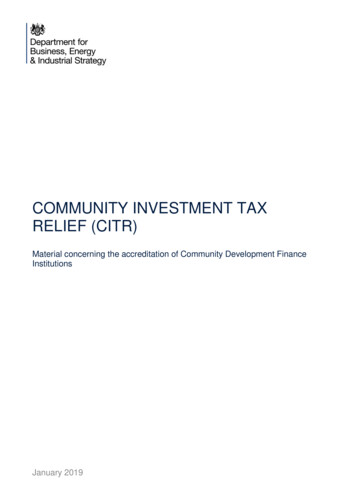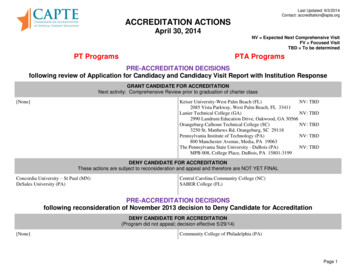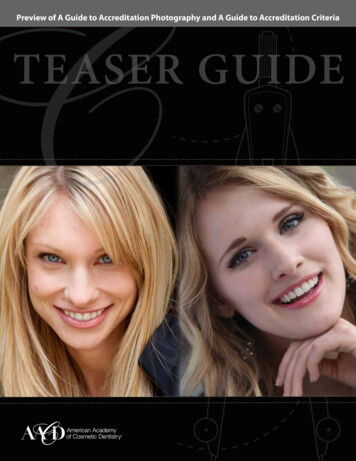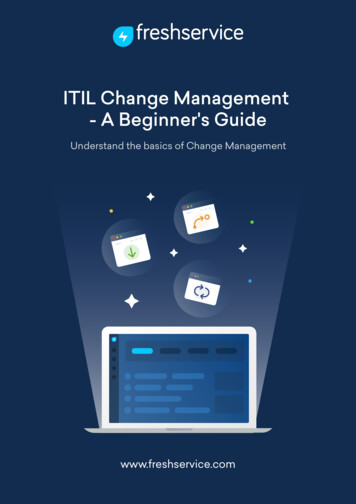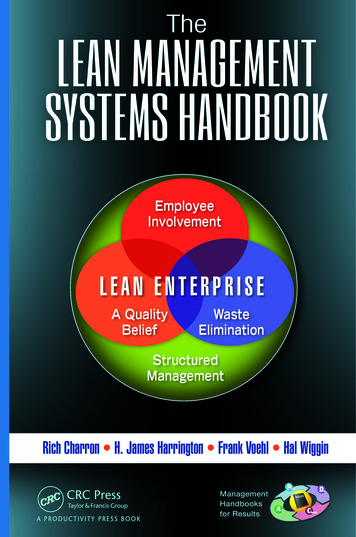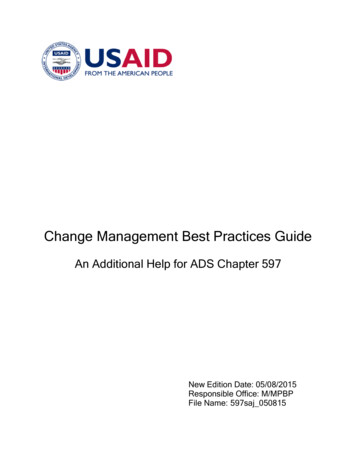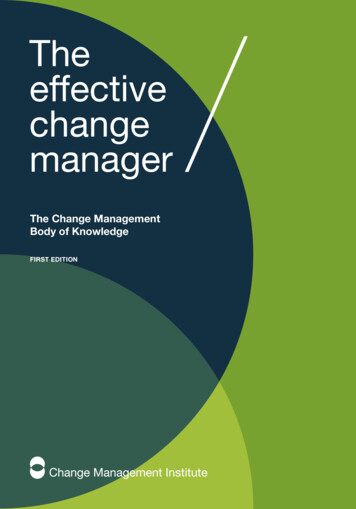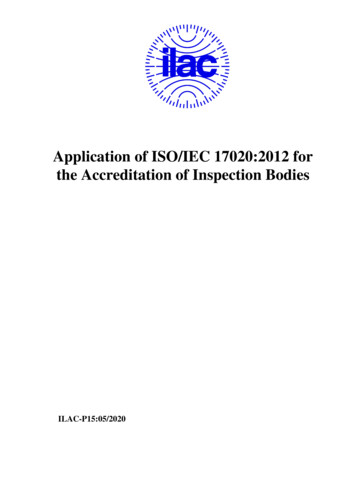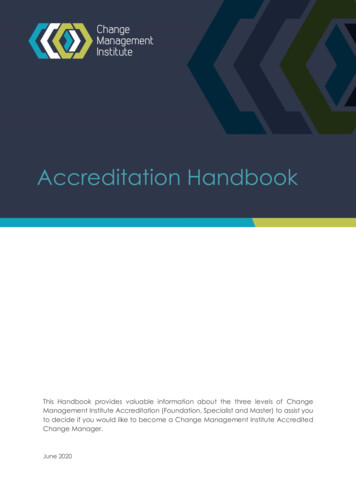
Transcription
–Accreditation HandbookThis Handbook provides valuable information about the three levels of ChangeManagement Institute Accreditation (Foundation, Specialist and Master) to assist youto decide if you would like to become a Change Management Institute AccreditedChange Manager.June 2020
Accreditation Handbook1. Accreditation Handbook22. Accreditation, the Competency Models and the CMBoK32.1 Accreditation Overview .42.2 Competency Model Overview .52.3 CMBoK Overview .73. The Three Levels of Accreditation4. Application Documents9135. Foundation Level145.1 Overview of the Process.145.2 Change Management Training .155.3 Written Application .155.4 Final Result and Feedback.185.5 ACM Foundation Logo and Certificate .186. Specialist Level206.1 Overview of the Process.206.2 Part 1 – Written Application .206.3 Part 2 – Virtual Interview .226.4 Final Result and Feedback.226.5 ACM Specialist Logo and Certificate .226.6 Process Timeline .246.7 Fast Track to ACM Master .247. Master Level257.1 Overview of the Process.257.2 Part 1 – Written Application .267.3 Part 2 – Virtual Interview .277.4 Part 1 & 2 Result and Feedback .277.5 Part 3 – Virtual Assessment Centre .287.6 Final Result and Feedback.287.7 ACM Master Logo and Certificate .287.8 Process Timeline .307.9 Fast Track from ACM Specialist .308. Accreditation Administration318.1 Contact Us .318.2 Accreditation Payment .318.3 Unsuccessful Applications .328.4 Accreditation Renewal .328.5 Accreditation Assessors .33Appendix – Application Fees34Page 1
1. Accreditation HandbookThe purpose of this Handbook is to inform you about what is involved in becoming aChange Management Institute Accredited Change Manager (ACM).It provides valuable information about what Change Management InstituteAccreditation is and the three different levels (Foundation, Specialist and Master). Youwill also learn about the key related resources of the Change Management InstituteChange Manager Competency Models (Competency Models) and ChangeManagement Institute Change Management Body of Knowledge (CMBoK). The ACMapplication form content is outlined, along with administrative processes and timing.This information will help you to determine if Change Management InstituteAccreditation is right for you, and which level of accreditation may suit. If you havefurther queries after reading this Handbook please contact us ataccreditation@change-management-institute.com.If you decide to move ahead with Change Management Institute Accreditation,please ensure you are a current member and review the relevant documents in detailie, the Competency Model, Application Form, and Application Guidelines. It isessential to ensure you have critically evaluated your capabilities against thebehaviours described in the relevant Competency Model and that you are able tomeet the professional development and referee requirements outlined in theApplication Guidelines.If Change Management Institute Accreditation is not currently right for you, weencourage you to use the Competency Models to evaluate your existing changecapabilities and identify areas to advance your change management expertise. TheCMBoK is also a great source of information about the underlying knowledge thatchange practitioners need.Page 2
2. Accreditation, the Competency Models and theCMBoKThe Competency Models and the CMBoK are key resources for those seeking tobecome an Accredited Change Manager. The Competency Models are theaccreditation assessment standard and the CMBoK describes the knowledgeunderpinning the models.Page 3
2.1 Accreditation OverviewThe Change Management Institute is committed to the creation and promotion ofprofessional standards in Change Management. In a world of disruption, those withproven change capabilities are constantly sought after in the marketplace. Employersand recruiters know that a Change Management Institute Accredited ChangeManager has undertaken an independent assessment of their capabilities.The Change Management Institute has three levels of accreditation: Foundation,Specialist, Master. These three levels cater for the full spectrum of changemanagement career progression providing members with access to a relevantassessment of their capabilities.Change Management Institute Accreditation is not a training course, it is anindependent assessment of your existing capabilities as a change professional – whatyou have actually done and achieved in practice.The assessment standard for Change Management Institute Accreditation is theChange Management Institute Competency Models.Page 4
2.2 Competency Model OverviewThe Competency Models have been developed by the Change ManagementInstitute in consultation with practitioners and employers across the world.The Competency Models are clusters of behaviours that are related to success in agiven role. These Models provide a strong focus on what change professionals canand would be expected to do in their roles. Refer to the CMBoK for guidance on whatChange Managers must know in order to display those competencies effectively.The Competency Models are a valuable resource for individuals and organisations: Members can review the Models to help build their skills and capabilities, or toprepare themselves for Accreditation.Organisations can build change capability in their human resources, changemanagement and project teams.Recruiters can ensure they are seeking the full breadth and depth of skillsrequired for change management roles.Training and education providers can use the Models to assist with their coursecurriculum and learning modules.Three Competency Models have been developed for Change Managers at differentpoints in their career – Foundation, Specialist, Master. The skill topic areas are similaracross the Models, but the key difference is in the depth and breadth of experienceexpected at each level. The different levels are documented together to enable youto see the areas of difference.Members can review the Competency Model on the website. If you are not yet amember you might like to take a look at the Competency Model preview documentavailable on the m/competency-modelPage 5
The Competency AreasThe skill topic areas are similar across the Models, the following lists all areas andhighlights those that only apply to specific levels. Facilitating ChangeThinking and JudgementInfluencing OthersProject ManagementCommunicating EffectivelySelf ManagementFacilitation – MeetingsProfessional DevelopmentSpecialist Expertise – TrainingSpecialist Expertise – CommunicationImpact Assessment (Foundation only)Strategic Thinking (Specialist and Master only)Coaching for Change (Specialist and Master only)Page 6
2.3 CMBoK OverviewThe Change Management Body of Knowledge (CMBoK) is entitled ‘The EffectiveChange Manager’. It is available in hard copy and digital formats and represents aglobal standard in Change Management.The Change Management Institute and APMG International formed a strategicpartnership to develop the CMBoK and promote its worldwide use and adoption asbest practice for Change Management.Informed by international research and peer review,the CMBoK represents one of the best resources forthe professional Change Manager and thoseorganisations seeking to improve their changemanagement capability.This first edition draws on the experience of more thansix hundred Change Management professionals inthirty countries.Starting with the Competency Model (what ChangeManagers do), the CMBoK describes what ChangeManagers must know in order to display thosecompetencies effectively and to deliver changesuccessfully.CMBoK is designed for practitioners, employers, authors, academics and anyone withan interest in this growing professional discipline.It provides: An outline of the required knowledge to deliver change successfully forpracticing or aspiring Change Managers.A description of the depth and breadth of Change Management expertisethat employers can reasonably expect of an effective Change Manager.Well-researched information on which to base books and courses, foracademics, trainers and educators.The CMBoK is a key resource for those seeking to become Change ManagementInstitute Accredited Change Managers. It describes the knowledge underpinning theaccreditation assessment standard – the Change Manager Competency models.The CMBoK is also the reference text for the education component of ChangeManagement Institute’s Accredited Change Manager (ACM) Foundation Level.Page 7
Foundation level applicants need to demonstrate they have successfully completedchange management training courses that cover key knowledge areas of theCMBoK.View a sample chapter of the CMBoK on the m/buycmbokThe CMBoK AreasThe CMBoK does not need to be read from front to back, all 14 knowledge areas canbe read separately. These are1. A Change Management Perspective2. Defining Change3. Managing Benefits4. Stakeholder Strategy5. Communication and Engagement6. Change Impact7. Change Readiness8. Planning and Measurement9. Project Management10. Education and Learning Support11. Facilitation12. Sustaining Systems13. Personal and Professional Management14. Organisational ConsiderationsPurchasing the CMBoKMembers can purchase the hard copy or digital CMBoK directly from our publishingpartners in Australia and the UK at a significantly discounted price (available tomembers around the world but payment is in AUD/GBP).Refer to the Change Management Institute’s website for more e.com/buycmbokPage 8
3. The Three Levels of AccreditationFind the right accreditation level for you. Have you nailed the Foundations? Are youa Specialist in your field? Or are you already a Master change practitioner?A high level summary of the 3 levels of Accreditation:The nature and extent of experience noted above provides a general guideline only.There are no specific rules around the years of experience required or the types ofassignments you need to have completed before you can apply for a specificaccreditation level.The following information provides a more detailed picture of the kind of experienceand capabilities that candidates at each level might have.A Foundation level practitioner understands the principles and actions underpinningsuccessful implementation of workplace change. They have the skills and knowledgerequired to provide support to senior change practitioners in the analysis, planning,administration and implementation activities of a change program.Page 9
Foundation level accreditation is likely to suit practitioners with knowledgecertification and 1 to 2 years change management experience, typically operatingat the project level as a junior change manager or change analyst. Their primaryrelationships are likely to be within the project team, with business change championsand human resources.A Specialist level change practitioner has the expertise to apply the changeprinciples, processes, behaviours and skills necessary to effectively prepare animpacted audience for sustainable change.Specialist level accreditation is likely to suit practitioners with around 3 to 6 yearsdedicated change management experience, typically operating at the project orprogram level. The change practitioner is likely to have end-to-end responsibility forpreparing an impacted audience for a sustainable change. Their primary relationshipsare likely to be the project team, impacted leaders and business stakeholders.A Master level change practitioner has mastery of the change principles, processes,behaviours and skills necessary to effectively identify, manage, initiate and influencechange, and manage and support others through it.Master level accreditation is likely to suit practitioners with 7 years of experienceincluding senior change management roles typically in large programs, portfolio ororganisational wide. The practitioner is likely to have end-to-end responsibility forpreparing a broad audience for a series of sustainable changes driven byorganisation-wide strategic priorities. Their primary relationships are likely to be seniorbusiness leaders including executive team and Board members.Where to startThere is no requirement to start at Foundation, move on to Specialist and thencomplete Master level Accreditation. Members are encouraged to apply for theaccreditation level that is the best fit for their skills and experience e.g., highlyexperienced senior change practitioners can apply for Master level directly and willbe assessed against the Master level Competency Model.The critical consideration for determining which level of accreditation to apply for is aself-assessment of your current capabilities against the Competency Models. Asdetailed in section 2.2 above, three Competency Models have been developed forChange Managers at different points in their career – Foundation, Specialist, Master.The different levels are documented together in a summary document to enable youto see the areas of difference. The specific Master level behaviours are highlighted initalics.Page 10
Members can review the Competency Model on the website. If you are not yet amember you might like to take a look at the Competency Model preview documentavailable on the m/competency-modelCompetency Model example – the three levelsThe following is an extract from the Competency Model document that illustrates thedifferences between the levels that can exist in some of the competency areas.The Competency Area example is “Communicating Effectively” with two of thesubskills detailed below “Relationship Building” and “Empathy”.COMMUNICATING EFFECTIVELYDefinition: The building and maintaining of open, collaborative and reciprocalrelationships with othersFoundationSpecialistMasterUnderstands collaboration andhow to develop it inrelationshipsUnderstands collaboration andhow to develop it inrelationshipsUnderstands collaboration andhow to develop it inrelationshipsActively supports teamworkthrough collaboration andeffective relationshipsActively supports teamworkthrough collaboration andeffective relationshipsActively supports teamworkthrough collaboration andeffective relationshipsCreates and maintains valueadded relationshipsCreates and maintains valueadded relationshipsBuilds rapport and keeps othersin the loopBuilds rapport and keeps othersin the loopFacilitates the discussion ofconflicting issues betweenindividuals and groupsFacilitates the discussion ofconflicting issues betweenindividuals and groupsCollaborates with others, seeksand utilises feedbackCollaborates with others, seeksand utilises feedbackRelationship BuildingApplies principled negotiationto achieve win/win outcomes indealings with othersEmpathyIs attentive to cues (e.g. bodylanguage), and respondsappropriatelyIs attentive to cues (e.g. bodylanguage), and respondsappropriatelyIs attentive to cues (e.g. bodylanguage), and respondsappropriatelyCan relate to people and listeneffectively to their viewpointDemonstrates empathy, canrelate to people and listen totheir viewpointDemonstrates empathy, canrelate to people and listen totheir viewpointUses empathy to considerstakeholder views, planstakeholder engagement, planPage 11
and prioritise activities andtailor communication materialsWhat is involved in each level of AccreditationEach higher level of Accreditation introduces an additional element to the process:1. Foundation – written submission referee2. Specialist – written submission 2 referees virtual interview3. Master – written submission 2 referees virtual interview virtual assessmentcentreEach of the above elements are detailed in the relevant section of this Handbook: ACM Foundation – Section 5 ACM Specialist – Section 6 ACM Master – Section 7Page 12
4. Application DocumentsAccreditation is available to members only. If you’re not yet a member and would liketo join, please refer to our m/join-nowFull application documents are available to members via the website. This includesthe Competency Model, Application Form and the Application Guidelines. Learnmore about what is included in the application forms in the Foundation, Specialist andMaster sections of this document.To access the application documents, refer to the relevant level of accreditation onour ent-institute.com/acm-masterIf you are not yet a member this Handbook will inform you about what is involved inbecoming an Accredited Change Manager. You can also access a preview of theCompetency Model on the /competency-modelPage 13
5. Foundation LevelFoundation level accreditation is an opportunity for those early in their changecareers to assess change management skills and areas for development.A Foundation level Change Manager understands the principles and actionsunderpinning successful implementation of workplace change. They have the skillsand knowledge required to provide support to senior change practitioners in theanalysis, planning, administration and implementation activities of a change program.It is likely that Foundation level candidates will have around 1-2 years changepractitioner experience, typically operating at the project level possibly as a juniorchange manager or change analyst. Candidates also need to have successfullycompleted formal change management training as outlined below.5.1 Overview of the ProcessTo gain Foundation level accreditation your capabilities will be assessed against thebehaviours outlined in the Change Manager Competency Model – Foundation level.The assessment comprises a written application providing evidence of your practicalcapabilities in a number of the competency areas, supported by a reference from amanager who has directly observed your behaviour in a change management role.You will also have completed relevant change management education; either aChange Management Institute endorsed course or other training courses that alignsto the CMBoK. For courses that haven’t been endorsed by the Change ManagementInstitute you will need to demonstrate how the course content covered specificCMBoK knowledge areas.Page 14
5.2 Change Management TrainingYou will need to provide evidence of your formal change management training. Thismust be in the form of a ‘pass’ or other successful result from either: Change Management Institute endorsed courses; orOther qualifying coursesThe courses that are currently endorsed by the Change Management Institute arelisted on the website at ngThere is a lower application fee for applicants with endorsed education due to thelower assessment time required. Refer to the Appendix for details of application fees.If you haven’t completed any of the courses that have been endorsed by theChange Management Institute, you can still apply to become an ACM Foundation. Ifyou have undertaken other formal change management training you can checkwhether those courses will provide the required evidence. The key evidence requiredis proof of successful completion and course content with sufficient coverage of theCMBoK knowledge areas. You will need to be able to demonstrate the links from yourcourse content to CMBoK in a summarised form in your written application. Refer tothe extracts from the application form below for more information about what you willneed to document.5.3 Written ApplicationThe application documents for ACM Foundation are available on the m/acm-foundationWritten submissionThere are two components to the written application:1. Evidence of change management education2. 250/400 word submissions of practical capabilities for 9 competency areasThe below are extracts from the ACM Foundation Application Form illustrating thecomponents of the application.Change Management Education – Change Management Institute Endorsed CoursesPage 15
Change Management Education – Other CoursesIf you haven’t completed a Change Management Institute endorsed trainingcourse, the below illustrates the kind of content you will need to provide about thechange management training courses you have attended. You can provide detailsof up to 4 relevant courses and need to identify the CMBoK areas that have beencovered by the courses. The below is an extract only, it is not the full section of theapplication form.Page 16
Change Management Practice – 9 Written SubmissionsPage 17
Reference CheckThe ACM Foundation application includes feedback from a manager who you havereported to for a period of at least 4 months during the last 3 years. Feedback fromyour referee is obtained via an online questionnaire. The questions are similar to anemployment reference check and will seek to identify examples of behaviours youdemonstrated during the project/engagement. The referee feedback will takeapproximately 20 – 30 minutes to complete.It is critical your referee has directly observed you in change situations. Your refereemust be very familiar with the specifics of what you have done and be able toarticulate in writing how you did it.5.4 Final Result and FeedbackAfter the evidence from your written application and reference checks has beenassessed you will receive an overall successful/unsuccessful result by email. You willalso receive a report from your Assessor identifying the specific competency areaswhere you have successfully met the required standard and any areas where youhave not been successful. You will receive your result within 6 weeks of submitting yourapplication.If you receive a successful result you will be awarded the ACM Foundation levelaccreditation. For further information about unsuccessful results please refer to section8.3.5.5 ACM Foundation Logo and CertificateUpon achieving your accreditation, you will receive an ACM Foundation certificateand electronic logo to recognise your achievement.The logo can be used in your professional profiles including email signature, businessrelated collateral such as business cards and websites.Rather than using a post nominal of ACMF we recommend you use the accreditationname in full where possible or shorten it to ACM Foundation to ensure it is meaningfulfor the reader.Page 18
The logo and post nominal may not be altered in any way. They may only be usedwhile Change Management Institute membership remains current.Page 19
6. Specialist LevelTo gain Specialist level Accreditation your capabilities will be assessed against thebehaviours outlined in the Competency Model - Specialist level.A Change Manager Specialist practitioner has the expertise to apply the changeprinciples, processes, behaviours and skills necessary to effectively prepare animpacted audience for a sustainable change.It is likely that Specialist level candidates will have around 3-6 years changepractitioner experience, typically operating at the project or program level.6.1 Overview of the ProcessTo gain Specialist level Accreditation your capabilities will be assessed against thebehaviours outlined in the Competency Model - Specialist level.The ACM Specialist is a two part assessment process which will evaluate your changemanagement capabilities in multiple ways – a written submission, referee feedback,and a one-on-one interview.6.2 Part 1 – Written ApplicationThe application documents for ACM Specialist Part 1 are available on the m/acm-specialistWritten submissionThere are three components to the written application:1. Evidence of professional development2. 250 word submission for 5 competency areas3. 2,000 word essayPage 20
The below are extracts from the ACM Specialist application form illustrating the threedifferent components.Please note, the ACM Specialist application form is the same as the ACM Masterlevel application form. It is expected that the answers given in the applicationreflect the respective level of the Competency Model and the nature and extent ofthe candidate’s experience. Many of the skill topic areas outlined in theCompetency Models are the same for both the Change Manager – Specialist andChange Manager – Master, it is the depth and breadth of experience that differsand this is reflected in the levels of behaviour.Referee FeedbackACM Specialist Part 1 includes feedback from two workplace referees. Feedbackfrom referees is obtained via an online questionnaire. The questions referees are askedto respond to are similar to an employment reference check and will seek to identifyexamples of behaviours you demonstrated during the project/engagement. Thereferee feedback will take approximately 30 – 45 minutes to complete.Page 21
It is critical to be able to provide 2 referees who have directly observed you in changesituations within the last 5 years. Your referees must be very familiar with the specificsof what you have done and be able to articulate in writing how you did it. You needto provide one referee on the delivery side of the change (i.e., sponsor) and one onthe receiving end of the change (i.e., impacted stakeholder).6.3 Part 2 – Virtual InterviewAfter your Part 1 written application and referee feedback has been assessed, youwill be invited to participate in a virtual interview with your Assessor. Your interviewmay be up to 1 hour duration and you will be asked questions about your changemanagement practice. Your assessor will also be seeking evidence of yourcapabilities in competency areas where insufficient evidence has been obtained inPart 1.6.4 Final Result and FeedbackAfter the evidence from your Part 1 application and Part 2 interview have beenassessed, you will receive an overall successful/unsuccessful result by email. You willalso receive a report from your Assessor identifying the specific competency areaswhere you have successfully met the required standard and any areas where youhave not been successful.You will receive your result within 6 weeks of submitting your complete Part 1application. This timeframe is subject to your availability to participate in the Part 2virtual interview.If you receive a successful result you will be awarded the ACM Specialist levelaccreditation. For further information about unsuccessful results please refer to section8.3.6.5 ACM Specialist Logo and CertificateUpon achieving your accreditation you will receive an ACM Specialist certificate andelectronic logo to recognise your achievement.The logo can be used in your professional profiles including email signature, businessrelated collateral such as business cards and websites.Page 22
Rather than using a post nominal of ACMS we recommend you use the accreditationname in full where possib
The purpose of this Handbook is to inform you about what is involved in becoming a Change Management Institute Accredited Change Manager (ACM). It provides valuable information about what Change Management Institute Accreditation is and the three different levels (Foundation, Specialist a

